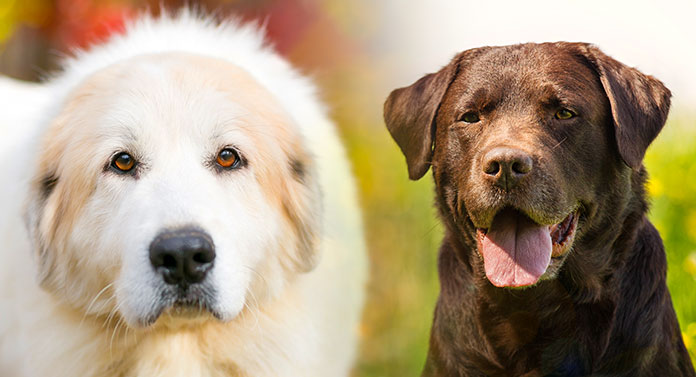
The Pyrador is a hybrid designer breed. A Great Pyrenees Lab mix, they are typically big, bold, confident, affectionate, loyal and athletic. Their stunning looks are only matched by their incredible range of designer hybrid dog names that extend to include Lapyrenees, Pyrelab, or Labrenees! An adult Pyrador could be 32 inches tall and weigh 100lbs and live around 12 years. They will need lots of space, attention, exercise and training to avoid potential problem behaviors.
Contents
- Working Pyrador histories
- Appearance, colors, grooming and shedding
- Are Great Pyrenees Lab mixes friendly?
- Training, exercise and health
- Pyrador puppies and breeders
You can expect a Great Pyrenees and Lab mix to be friendly and energetic, but they may have strong hunting instincts. Are you ready to find out if the Pyrador is right for you?
Hard Working Histories
The mix has been bred as a family companion, but its parent breeds once had quite different purposes. Let’s take a closer look at each parent breed to find out a little more about where our new mix comes from.
The Great Pyrenees dog was bred in the Pyrenees Mountains between France and Spain. Evidence shows that these dogs may have been bred as early as 3,000 B.C.
Pyrenees dogs would guard their master’s sheep from wolves, bears, and other predators found in the mountains. Sometimes, they would have to stay high in the cold mountains for days on end, but luckily, they had their signature white coats to keep them warm!
The Labrador Retriever comes from Newfoundland, Canada, where small dogs were trained to retrieve waterfowl. Their ancestors were brought across to the UK, where the Labrador breed was eventually standardised. Today, Labradors still make excellent hunting dogs as well as service dogs, but they’re most popular as pets.
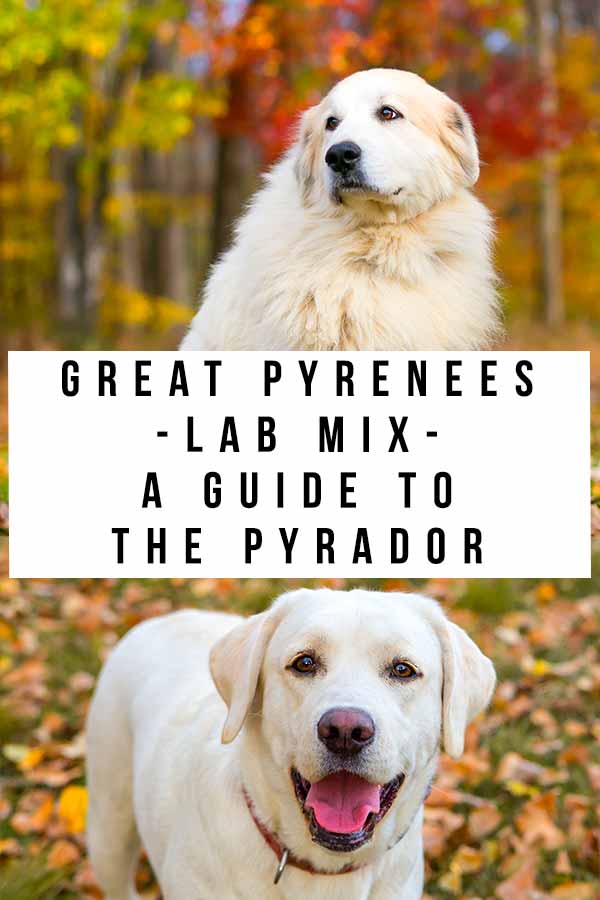
Pyrador Appearance
As we know, this mix can inherit any traits from either parent breed. So, puppies can look like Labs, Great Pyrenees, or anything inbetween. A Great Pyrenees and Lab mix will have a double-coat, which may be short like the Lab’s coat or long and thick like a Pyrenees’ coat. A popular variety is the Great Pyrenees black Lab mix, to achieve that black coat. But, a Great Pyrenees black Lab mix will still have unpredictable fur lengths.
Depending on which parent a Lab and Pyrenees mix resembles, her coat may be solid yellow, black, or chocolate like a Labrador. Or her coat may be white or off-white with badger, gray, tan, or reddish brown markings like a Great Pyrenees.
Grooming
The Pyrenees sheds its entire undercoat seasonally, and the Lab also sheds pretty heavily seasonally. So, a half Lab half Great Pyrenees will definitely be a heavy shedder.
To combat all of the hair, especially if a Pyrador has a long outer coat, you’ll want to run a brush over their coat at least weekly. The good news is, a Pyrador with a typical Great Pyrenees coat will not need much other grooming, as its coat will be tangle- and dirt-resistant.
Are Pyradors Hypoallergenic?
Unfortunately the Great Pyrenees and the Lab are both high shedding breeds. Your puppy will be a shedder, and not an allergy friendly pet.
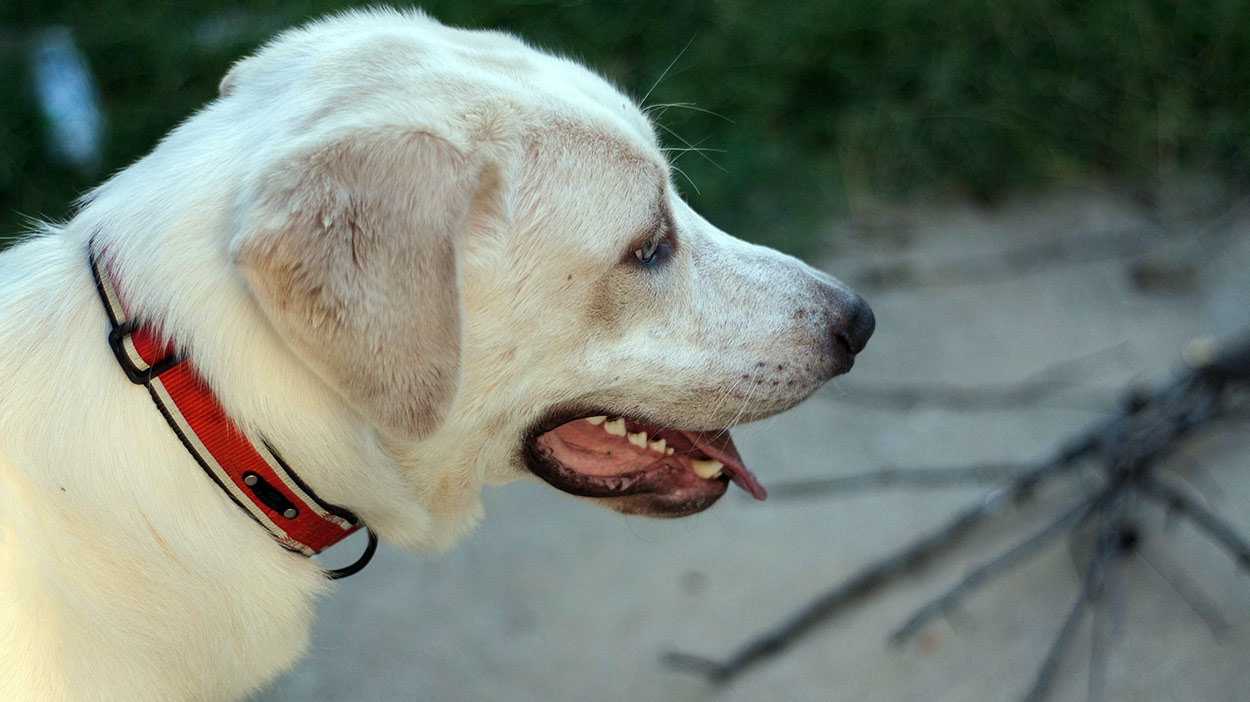
Pyrador Height and Weight
With both parents being larger dogs, a Great Pyrenees and Lab mix definitely has some big shoes to fill. According to Labrador and Pyrenees’ standard sizes, a Pyrador may reach anywhere from 21.5 to 32 inches tall at the shoulder.
Pyradors that take after the Lab parent’s size will be a bit smaller, while those which take after their Great Pyrenees parent will be the largest. Generally speaking, females will be shorter and lighter than males.
Pyradors may weigh anywhere from 55 to 100+ pounds, but many do not reach full Pyrenees height and weight.
Great Pyrenees Lab Mix Temperament
Both parent breeds of this mix were once working dogs. Labradors are categorized now as sporting dogs, whereas the Great Pyrenees is categorized in the working group. The mix can inherit the patience of the Pyrenees with just a little bit of playfulness from the Labrador. But, not all Pyradors have the temperament that we described above.
Mixed breeds can be an equal mix of both parents, or they make take after one parent more than the other. So a Pyrador might be a mostly quiet and patient dog with a little bit of protective instinct, like his Great Pyrenees parent, or he might be a little more rambunctious with retrieving instincts, like his Labrador parent.
Pyrador Personality
A dog with strong Great Pyrenees genes may have a tendency to herd or chase after other dogs, cats, or other small animals. This could make them hard to keep in a multi-pet household. Plus, they may exhibit guarding tendencies and be extremely loyal to their owners and property. They may bark and growl at someone or something that they perceive to be a threat to their home.
Pyradors with stronger Labrador tendencies may be highly energetic and prone to mischief. If a Pyrador acts more like a Lab, then they may have an issue with being left alone for extended periods of time. Labs do not take kindly to solitude and need a friend. Have them let out by a dog walker a couple of times if you’re not able to be home.
They can also be quite destructive when they are upset or bored. With their powerful jaws, they can chew through just about anything that’s not an indestructible dog toy.
Are They Good With Kids?
Most Pyradors are great with children. But we do recommend that you supervise play between children and Pyradors, as the Pyrador’s large size may make play a little too rough with small children.
Training
Crate training is often useful for many owners of this mix. As Pyradors will often be very large, puppies must undergo obedience training from a very young age.
They may not know their own strength when they are fully grown, and the friendliest pup can easily hurt someone without meaning to. Training will help you avoid this scenario. It can also help to reduce hunting instincts. Although, it may be best to avoid the risk, and choose a different breed if you have other small pets at home.
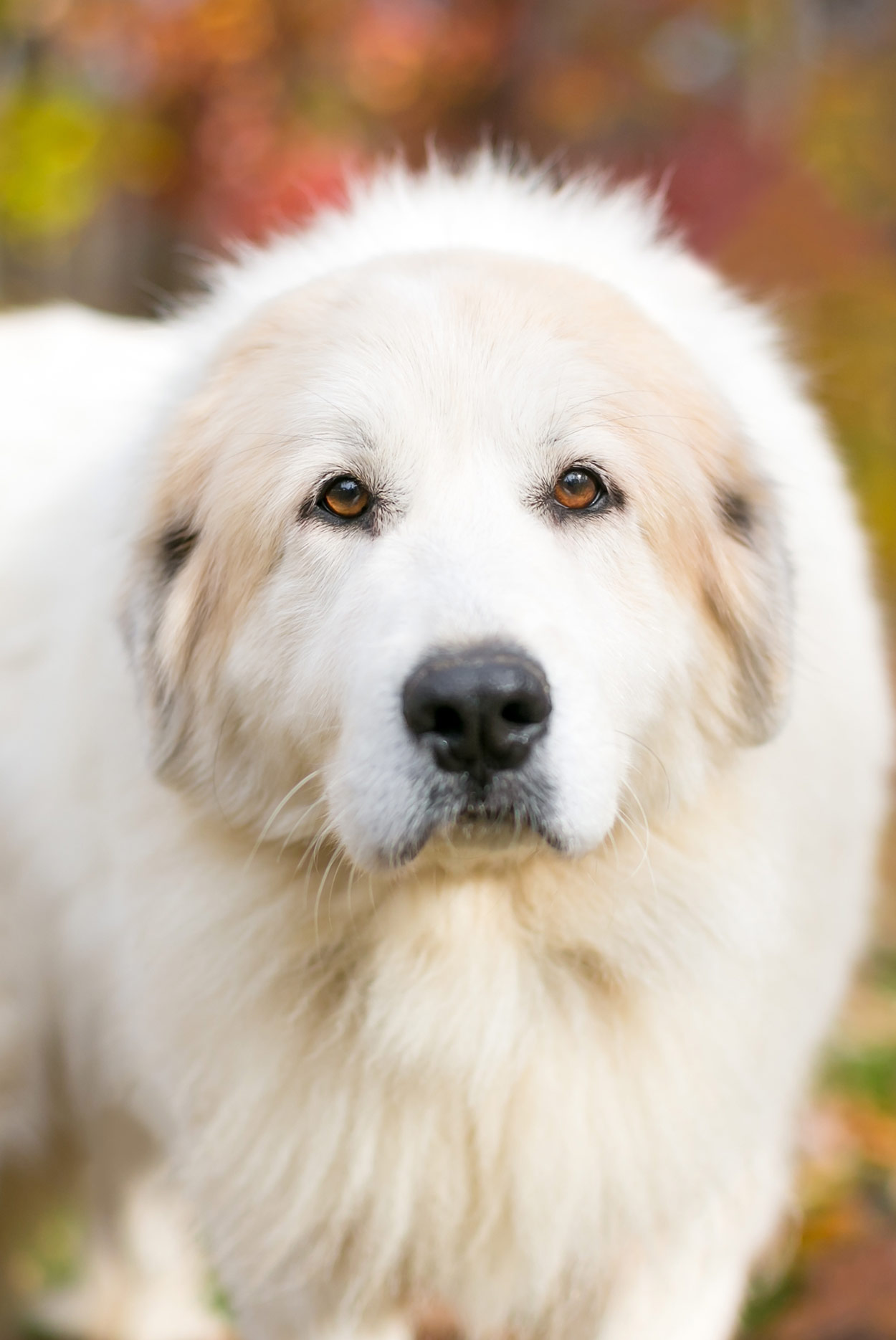
Exercising Your Pyrador
While both parent breeds were working dogs, Pyrenees mixes do not necessarily require a large yard to roam in. They are usually fine if they get at least one long walk in each day.
If they have a little more of the Lab’s energy, then they could use some extra play time. You’ll need to keep a close eye on a Great Pyrenees Lab mix that’s off leash in an open area. His old hunting instincts may lead him to follow his nose or a tasty-looking bunny!
If a Pyrador has English Lab in him, he may not inherit as strong of a hunting instinct. Any Pyrador would do better with a fenced-in yard to keep them from wandering after a scent or running an “intruder” off.
Pyrador Socialization
As well as training from a young age, this mixed breed will need to be well socialized as early as possible. This means introducing your puppy to as many new environments, people, things, and animals as possible.
Socialization can help to reduce fear based aggression in puppies, and will help your dog grow up to be happy and confident in all situations.
Dogs with potential guarding tendencies should be socialized well to combat the risk of aggression as adults. Given the protective instincts of the Great Pyrenees parent, and the sheer size of this mix, socialization is important for all new owners.
Hybrid Dog Health
Some people mistakenly believe that hybrids are achieved through inbreeding and/or are riddled with health issues due to them being a combination of breeds. However, as long as breeders health test dogs they intend to breed from, and avoid inbreeding of any kind, their mixed breed puppies are just as healthy as purebred dogs.
Purebred dogs are just as likely to have health problems as mutts. It all comes down to the following:
- the health of the breeding stock that start and maintain the line
- the conditions in which the parents and offspring are kept
- whether or not inbreeding is used to produce second and older generations.
Continuing to breed dogs with known health issues always results in more dogs with health issues. It doesn’t matter if they are a purebred or a mutt.
Great Pyrenees and Labrador Health
Pyradors may get any common canine ailments like hip dysplasia, eye diseases, allergies, and skin irritations. As a hybrid, Pyradors are subject to genetic conditions which are passed from their parents.
Generally, Labrador Retrievers and Great Pyrenees are both prone to obesity, hip and elbow dysplasia, and progressive retinal atrophy (PRA).
We cannot emphasize enough that you should purchase a Pyrador from a breeder that utilizes genetic testing. Knowing the genes that breeding stock will pass to their offspring can prevent the passage of unwanted health conditions. But, a healthy Pyrador can be expected to live for 10-12 years.
Do Great Pyrenees Lab Mixes Make Good Family Pets?
For the right family, the Pyrador mix can be a great choice. Their exercise needs, temperament, and appearance will vary depending on the traits they inherit from each parent breed. If they take after the Lab, they will be friendly, energetic, and playful. Those that take after the Great Pyrenees will be loyal, have guarding tendencies, and will need less exercise.
That doesn’t mean that a Pyrador will be happy in a small home or apartment, though. A large dog does need some room to move around while they’re inside, after all! An enclosed area for a Pyrador to roam outside in is a good idea.
They may inherit the Lab’s love of sniffing out game. Or they might get the Pyrenees’ tendency to go after people, animals, or things which they perceive to be a threat to their home. So, train and socialize this mix well from the time they come home as a puppy.
Although the Labrador is a fairly healthy dog, the Great Pyrenees may pass on one or more of the several health conditions common in their breed. So, choose the healthiest puppy possible. Or, consider rescuing an adult.
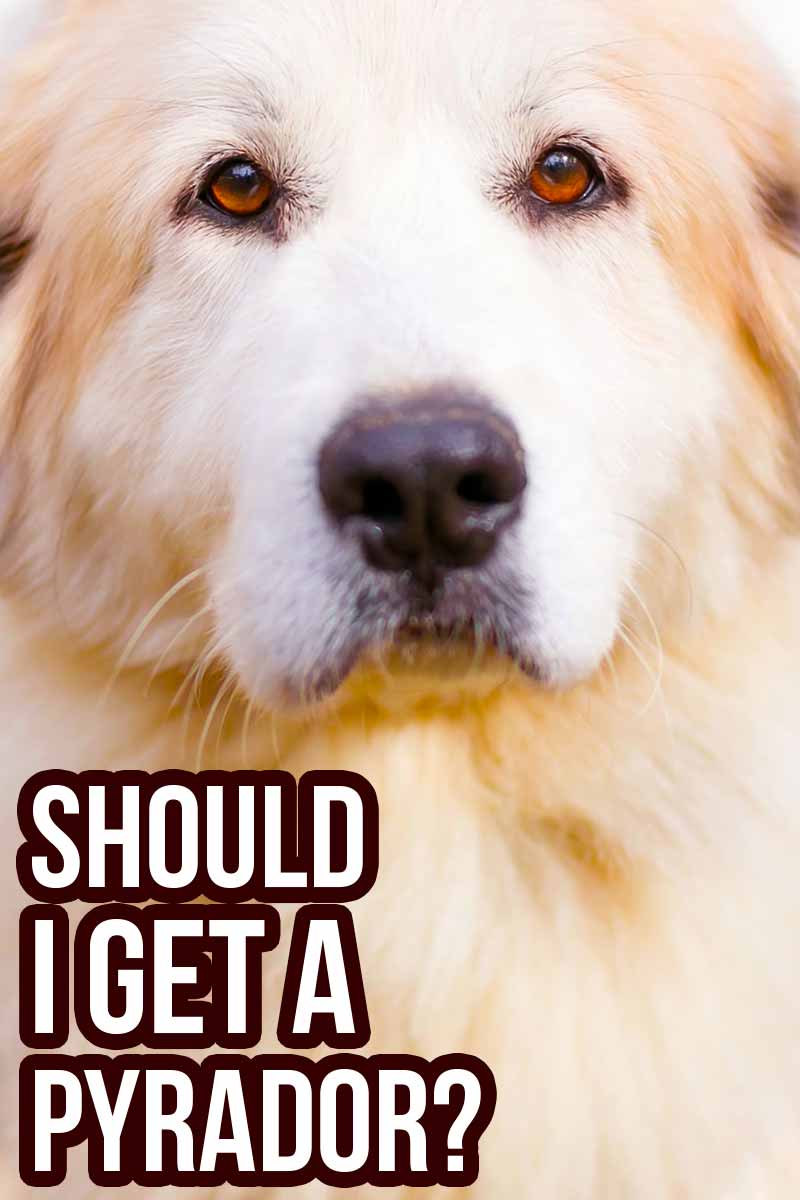
Rescuing a Great Pyrenees Lab Mix
You don’t have to buy a puppy from a breeder to get your very own Pyrador! All too often, adult dogs from all walks of life end up in shelters or animal rescues. This can be because their owners could not keep them for one reason or another.
Due to the number of health issues this mix can inherit from the Great Pyrenees parent, adopting an older dog can be a good way to give an abandoned adult a second chance at life. Some owners may give up their dogs as soon as they encounter costly health bills. So, you may find these mixes in rescues looking for loving homes.
Pyrador Breeders
Before buying a Pyrador, we recommend that you carefully research Pyrador breeders so that you only purchase from a responsible breeder. Responsible breeders use genetic testing to prevent the passage of undesired traits or health conditions.
They also keep their breeding stock (and puppies) at a good weight and in clean conditions—always. If a breeder does any of the following, then you might want to look for a puppy elsewhere:
- is unwilling to show you their entire facility
- has breeding stock or puppies that look ill
- does not use genetic testing
The price that you’ll pay for Great Pyrenees Lab mix puppies will vary based on how valuable the parents are to the breeder, the availability of puppies, and whether or not they’ve received various veterinary services (such as spaying, neutering, vaccines, etc.).
A Pyrenees Lab mix puppy may cost you anywhere from $500 depending on your location and the above factors.

Lisa says
My lab/pyr mix is a year old now. Had him since 6 weeks. He’s a beautiful, majestic white boy. Already huge, over 100 pounds. He’s a goofy, funny, loveable dog. He loves almost everyone. Especially kids. One exception is a neighbor, for some reason he actually growls at him. I honestly never heard him growl before. He tends to want to wander and chews everything. But he’s honestly a wonderful pet.
Danielle says
I want to breed my pyrenees with the lab trying to figure out how to go about it or if you have any available not asking for anything other than first pick of the litter
Susan says
Hi, I would love to buy or adopt a great pyr lab mix. I lost mine who was 12yrs and would love another one
Corinne says
We are looking at adopting a 4 month old lab mix with hind dew claws. Most likely a lab/gp mix. We do not have a fence, just invisible fencing that works pretty well for our pure american lab. Any recommendations, does this mix have strong runner tendencies?
Alexandria says
We adopted a lab mix from a no kill shelter a almost 3 years ago. I did my research and she looks like an almost pure-bred white english lab, but now that I see these pictures, I’m wondering if she’s a pyrador! She’s silly and sweet, but guards our home fiercely, and she loves to work.
Darlene B Gammill says
I adopted a Lab from a rescue.. She had had 13 pups. When I got her she was 65 pounds from nursing pups. Her foster keot telling me she was a big girl.. I could not bring her home until she weaned them. Been a year now and she weighs 102 pounds and she is tall . Great with people, kids and our cat. but will bark at people and dogs walking down the road with her tail wagging. She does not play with toys. She has a big fenced yard. The vet told me the other day at her checkup, that she looks like she may have pyrenees in her. I have not done a genetic test yet. She us yellow with a darker color down her back. Has a big fluffy tail.
Linda A West says
Our neighbor had this sweet all white puppy and had to go to assisted living and couldn’t take the puppy. We said we would find a good home for him but my granddaughter lives with us and she fell in love with this gentle creature. However, he is now HUGE. He doesn’t have the heavy coat of the Great Pyrenese but he does have the extra toes. After looking at your site, I believe he is mixed with lab. We have been bringing him indoors during the cold weather. He is afraid of the kitchen floor and spreads his legs out and kind of crawls on his belly. When he gets to the next floor, he stands up and walks. Both of the floors have laminate flooring but the kitchen floor is lighter. What do you think is the reason for this? Our grand-daughter was picking him up but he is too heavy now.
Kkirby says
Lots of dogs are afraid to walk on slick floors, wood, tile, linoleum… I put a runner across the floor for my dog and he walks on that.
Ann says
True, a Great Pyrenees is in the AKC working group, not herding group. They provide protection by staying with a herd of sheep, ready to become a most unwelcome surprise to predators. I can see how this could lead to problems in a home if a guest were mistaken for a predator of the flock.
Leslie Richardella says
We adopted a Pyrador pup @ 1 year of age .
He hadn’t been nurtured by then @ we think that helped his hormone level & healthy growth – he was soon neutered.. It was great traveling all around the country with him while never aggressive it totally surprised us when a friend ‘s young daughter visited – he never left her side as if guarding her – she was collecting bugs & he had to sniff out each one she picked up then returned to his guard stance. He let our cats eat & sleep on him .
We’ve had a variety of big dogs all our lives & everyone was very special .
“Buca” was beautifully & noble ,loyal , loving , friendly to all & cuddly -he maintained his rare sense of humor even when he became ill ..still very vocal .
Obviously. We are devastated & have begun our search for another .
That said – any help in finding one would be great ,
Enjoy you dog loves .
Jenna says
Our lab just had 5 pups on july 12th. They are a mix with our neighbors great pyrenees.
They will be ready by August 30th to go to a forever home.
Laura Wiener says
Hello I am very interested in one puppy 🙏🏼🙏🏼
Could you give me more info?
April Sparks Spàrks-Harmon says
I have 3 pyrador puppies. 8weeks old and iso their furever home. They are light brown, beautifully marked. Shots up to date, paper trained (i won’t let them out until vaccinations are finished), I desire more than anything for them to be loved. They were my oops litter. We rescued a black lab and was told she had been spayed….our Great Pyrenees got her pregnant so we quickly found out she wasn’t. U hate to think that u wouyadd one pup to the already tremendous number of homeless dogs. Most have already found wonderful homes and scattered about the US. Ga, Or , NJ, Illinois. They are raised inside my home with my dogs. Very well socialized, happy healthy puppies. If you know anyone who may be interested I am in Eastern KY, pls feel free to look me up on Facebook/Messenger. You’ll see pics there also. Thank you
Nan says
I rescued an 8 week old Pyrador pup 17 months ago and she has been a wonderful, smart and protective pup since I got her. I am now trying to find another Pyrador pup so that Haylie has a buddy but it has been difficult finding an available litter. I would appreciate it if anyone knows of breeders in Ohio or Pennsylvania that breed Pyradors..
Cherie Cockrell says
I have a 7 year old pyrador and he is the best dog ever! Everybody loves him. He is patient and calm and my best friend in the world! I would recommend them over any other breed any day! He is pure white and has a few stray black hairs, probably a dozen total. I honestly dont think i could ever have a better dog. The hair gets everywhere but the love and companionship are well worth a little clean up!
Debbie says
We have an 18-month-old pure white pyrador female. She loves our little Oscar who is a 7-year-old Fox Terrier mix. Although she is 73 pounds, she delicately plays with him. She is able to place his head in her mouth, but she never hurts him. When he gets tired of playing, he lets her know and she leaves him alone. She is a protective of us all. We love her and Oscar immensely.
Gail says
We got our Andy from an animal shelter.
He is 4 months and huggable!
He just doesnt have the energy of a lab, lives his walks and loves to get the mail and we let him hold it in his mouth to we get in the house.
Does suffer from anxiety issues when left alone 🙁 in his crate.
Still working on that.
James says
Have a white pyrodor mix make he is 6mths old great dog loving and very playful lots of energy. Gets along well with our four female German Shepards. But it’s afraid of squirrels best puppy to have.
Jeff & Jenn says
Our Pyrador loves everybody, and wants to be friends with every dog she meets. I have never had such a gentle dog. We got her from a an ad on Craigslist for free, so whomever got the rest of the litter also must have also got a great dog.
Sarah And Ashley says
We also got our love bug on Craigslist! She is the absolute best!! ❤️❤️
Eden says
What is Craigslist? Please respond as soon as possible. Thank you Eden.
Alexis kyle says
I have a black and white Pyrador named Poseidon he is such a great dog! I would not know what I would do with out my big ole baby. I got him at 2 months and about 5 days ago he turned a year and 3 months, he is healthy. Have not had signs of anything wrong with him. Great with kids and other animals i mean he chases our 2 cats but is afraid of our hamster. He just Loves everyone he meets. He loves the attention. Oh and he absolutely loves the snow I can barely ever get him inside with out him pulling away. He is a great dog no less!
I definitely recommend a Pyrador. There great for family dog or a working do does great in both areas.❤️️❤️️
JOHN says
i have a lab mix with pyrenese it is and amazing puppy we got him
at 3 months old and today he turns five months old. Very intelligent
was very easy to house train goes right to the door. He definitely will
be a large dog … When we got him at 3 months he was 22 pounds
and know he is 47 pounds So happy with are decision and he gets
along with my 8 year old Jack Russell ….
Sherrie Reed says
So happy I came across this article, because we rescued a puppy from an old storm drain in the rain. We could get the lab in him but couldn’t figure out the other breed because of his curly tail. I’m so excited we have 2 great dogs in 1!!
Diane Johnson says
I think I have one of these dog breeds. I got my King Louie from the local animal shelter. He has been trained to be my PTSD Emotional Support animal and he has surpassed my every dream.
I want to be able to send you a photo of him……to actually find out if he IS actually this breed; I know he is part Lab. Someone at the river this weekend pointed out that he looked like the Great Pyrenese.
Thank you for any information you can send me.